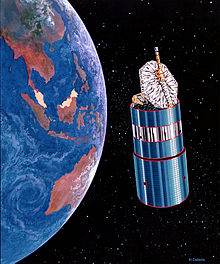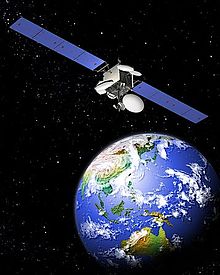- MEASAT Satellite Systems
-
 Technicians at Boeing's Space and Intelligence Systems satellite manufacturing facility in El Segundo, California, prepare the MEASAT-3 communications satellite.
Technicians at Boeing's Space and Intelligence Systems satellite manufacturing facility in El Segundo, California, prepare the MEASAT-3 communications satellite.
MEASAT Satellite Systems Sdn. Bhd., formerly Binariang Satellite Systems Sdn. Bhd is a Malaysian communications satellite operator.
MEASAT (Malaysia East Asia Satellite) is the name of a line of communications satellites owned and operated by the company.
As of 2006, the MEASAT satellite network consists of three geostationary satellites designed and built by Boeing Satellite Systems. MEASAT-1 and MEASAT-2 were launched in 1996 and MEASAT-3 in 2006.
The MEASAT-1 and 2 satellites were designed to provide 12 years of both direct-to-user television service in Malaysia and general communications services in the region from Malaysia to the Philippines and from Beijing to Indonesia. With the launch of MEASAT-3, the coverage extends even further to an area encompassing 70% of the world's population.
Contents
MEASAT-1 and MEASAT-2
In May 1994, Binariang Sdn. Bhd. of Kuala Lumpur and Boeing Satellite Systems signed a contract calling for the construction of the Malaysia East Asia Satellite (MEASAT) system. The system called for one Boeing 376 model spacecraft, equipment for a satellite control station on Langkawi Island, and training of Malaysian spacecraft controllers. Binariang exercised its option for a second satellite in January 1995.
MEASAT 1 has five high-power transponders in Ku band for the direct-to-user service, powered by 112-watt traveling-wave tube amplifiers. The regional service is provided on 12 transponders in C band, using 12-watt solid state amplifiers. MEASAT-2 has 11 active transponders in Ku band. Eight of these use 95-watt traveling-wave amplifiers, and three have 62 watts. There also are six active transponders in C band, powered by 12-watt solid-state amplifiers.
As Boeing 376 spacecraft, the MEASAT satellites have three enhancements over the standard model. They were the first in the Boeing 376 series to be fitted with gallium arsenide solar cells, which deliver 40 percent more payload power as compared to their silicon predecessors. They were also the first Boeing 376s to use Boeing Satellite Systems' lightweight, high-gain shaped antenna. The satellites also used a more efficient bipropellant system for stationkeeping and attitude control maneuvers.
Both MEASAT-1 & 2 satellites were launched on Ariane rockets from Centre Spatial Guyanais at Kourou in French Guiana. MEASAT-1 was launched in January 1996, and MEASAT-2 was launched in November 1996. MEASAT-1 is located in a geostationary orbit at 91.5 degrees East, and MEASAT-2 is located in a geostationary orbit at 148 degrees East.
On 13 January 2010 brought into service the AFRICASAT-2 satellite at the 5.7°E orbital location. The AFRICASAT-2 satellite was previously known as MEASAT-2 and had been operating at the 148°E orbital location. Now operating in inclined orbit at the 5.7°E orbital location, AFRICASAT-2 provides both C and Ku-Band capacity for telecommunications and broadcasting services across Africa, Southern Europe and the Middle East.
MEASAT-1 Orbital Location 91.5°East (0°00′N 91°30′E / 0°N 91.5°E) Geographic Coverage South East Asia, northern Australia and Guam Launch Year 1996 Present Status Operational Type of Satellite Boeing 376 HP Launch vehicle Ariane 4 Design Lifetime 12 years SSPA Power 12 Watts Transponder Bandwidth 12×36MHz Channel Polarization Linear MEASAT-3
Main article: MEASAT-3MEASAT-3 was launched successfully on the 12th of December 2006, 7.35 am (Malaysian Time, GMT +8.00 HRS) from the Baikonur Cosmodrome, Kazakhstan. [1]
MEASAT 3A
Main article: MEASAT-3AMEASAT-3A constructed by Orbital Sciences Corporation under their Star-2 production line was launched on 21 June 2009.
MEASAT 3B
MEASAT-3B to be constructed by EADS Astrium based on Eurostar 3000 platform. Launch is planned in 2013.
References
- Bigger, better and faster with Measat-3, The Star, December 12, 2006
- ILS Proton Successfully Launches MEASAT-3 Satellite, BAIKONUR COSMODROME, Kazakhstan, December 12, 2006
- Boeing Receives First Signal from New MEASAT-3 Satellite, ST. LOUIS, December 12, 2006
- Measat 3 Interference, Telco Talk Malaysia, April, 2007
External links
Categories:- Communications satellite operators
- Science and technology in Malaysia
- Companies of Malaysia
Wikimedia Foundation. 2010.


